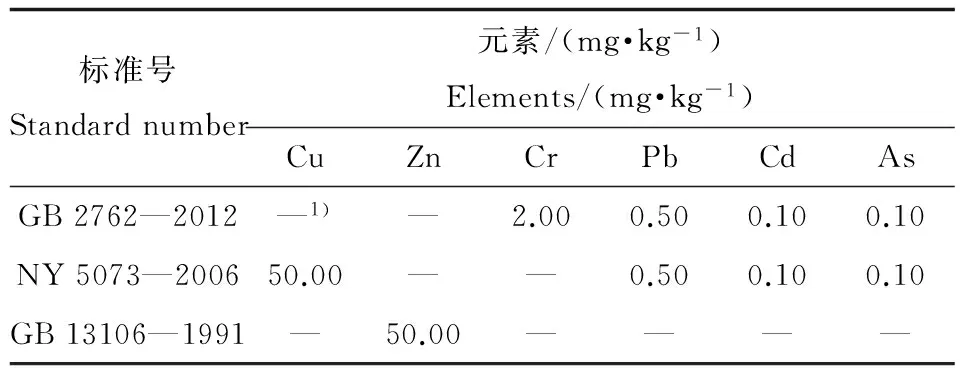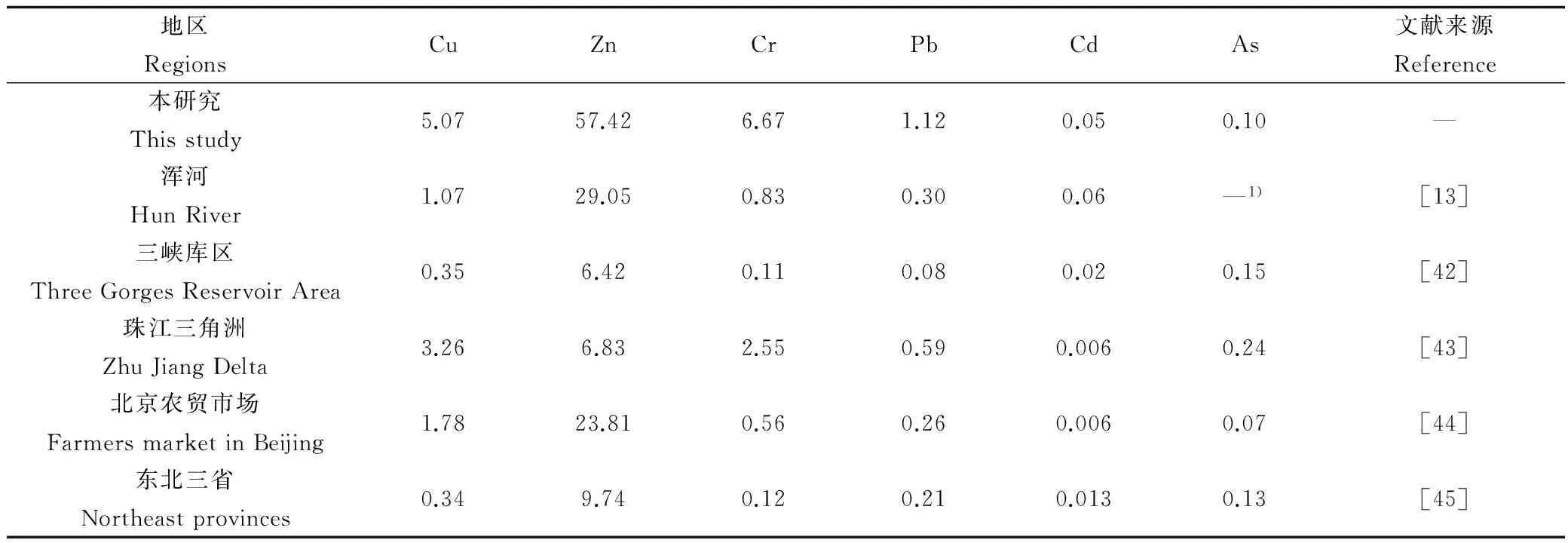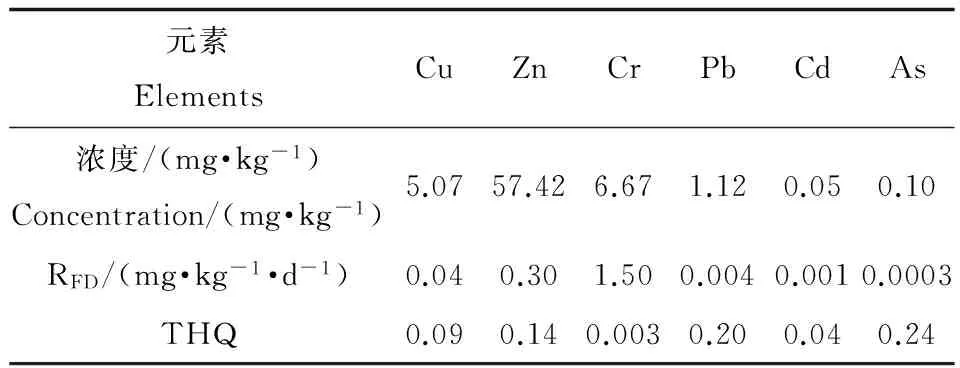滦河流域鲫鱼体内重金属分布及风险评价
王瑞霖,孙然好,武大勇
1. 北京化工大学环境科学与工程系,北京 100029 2. 中国科学院生态环境研究中心城市与区域生态国家重点实验室,北京 100085 3. 衡水学院生命科学系,衡水 53000
滦河流域鲫鱼体内重金属分布及风险评价
王瑞霖1,2,孙然好2,*,武大勇3
1. 北京化工大学环境科学与工程系,北京 100029 2. 中国科学院生态环境研究中心城市与区域生态国家重点实验室,北京 100085 3. 衡水学院生命科学系,衡水 53000
采集滦河流域鲫鱼样本并分析重金属元素(Cu、Zn、Cr、Pb、As、Cd)在其体内的分布特征及食用风险。实验结果表明鲫鱼体内重金属含量由高到低顺序为Zn>Cr>Cu>Pb>As>Cd,蓄积器官主要为肝脏和鳃部,Cu和Cr主要蓄积在肝脏,Zn、Pb、Cd主要富集在鳃部,As的蓄积器官随地域变化,而且下游样本中各组织器官重金属含量下游高于上游。针对鲫鱼肌肉的评价表明,Zn、Cr、Pb含量超出《无公害食品水产品中有毒有害物质限量》(NY5073—2006)、《食品污染物限量》(GB2762—2012)和《食品中锌限量卫生标准》(GB 13106—1991)规定的标准限值,超出倍数依次为Cr(3.34)>Pb(2.24)>Cd(1.15)。基于目标危险系数法(THQ)评价结果表明鲫鱼肌肉组织单一重金属THQ值均小于1,As导致的健康风险最高,Cr最低;总风险系数(TTHQ)显示下游的溯河(TTHQ=1.263)与陡河(TTHQ=1.381)存在食用风险,风险比重较高的元素是As、Pb、Zn。
重金属;鲫鱼;滦河;食用风险
随着工业化和城市现代化的发展,重金属已经成为水环境中普遍存在并具有潜在毒性的一种持久污染物[1]。重金属污染不仅对水生生物造成了严重的危害[2-3],还极易通过食物链传递到高等生物体内富集[4-5],并最终导致人体健康风险增加。鱼类作为水生生物常见种,不仅可以直接从水体环境吸收重金属,还因为位于水生生态系统顶端通过食物链吸收重金属并在体内积累富集。因此,鱼类体内的重金属含量在一定程度上可以很好地反映水环境的重金属污染状况及其对人体的健康风险[6-7]。
近年来,滦河流域也出现了重金属污染问题[8],大量的工业“三废”、农业及城市生活污水未经处理或处理未达标就直接排入水体,并对流域生活的居民健康造成潜在威胁[9]。虽然有研究关注到滦河流域水体[10]、沉积物[11]和土壤[12]的重金属污染状况,但鲜见有关滦河流域鱼体内重金属研究。由于鲫鱼能从水体中以及沉积物中吸收一定量的污染物(如重金属元素)并在体内器官富集[13-14],因此常被用作生物标志物来反映水体重金属的污染状况[15]。鲫鱼(Carassius auratus)是滦河流域河流中分布广泛[16]且易于采集的典型鱼种,也是当地居民日常消费及食用鱼种之一。因此,本研究选用鲫鱼作为反映滦河水生生态系统受重金属污染程度的指示生物并进行食用风险评价,旨在揭示滦河的重金属污染状况并为鱼类健康消费提供参考,以期为流域水环境重金属监控预警、风险管理提供科学依据。
1 材料与方法(Materials and methods)
1.1研究区概况及样品采集
滦河流域是海河三大子流域之一,位于东经115°30′~119°45′,北纬39°10′~42°40′,发源于河北省丰宁县巴颜图古尔山麓,于乐亭县流入渤海,流域面积44 750 km2左右。其中,山区面积43 940 km2,平原面积810 km2[17](图1)。
2014年5月在滦河干流及主要支流选取了13个采样点(图1),其中1~7号点位于流域的上游,海拔300~1 300 m,多为丘陵、山地和高原区域;8~13号属平原下游区域,海拔小于200 m。鲫鱼采用挂网、电击和垂钓等方式捕获,捕获后筛选5条体长8~9 cm,体重30~34 g体表无明显损伤、活力较强的鲫鱼,现场测量体长和体重后用河水洗净后装入密封袋,并置于车载冰箱中冷冻保存。

图1 滦河流域采样点分布Fig. 1 Sampling sites in the Luan River
1.2样品处理及分析
将冻存的鲫鱼解冻后用蒸馏水洗净,经不锈钢刀解剖,剔除鱼鳞、鱼刺等,分别取肌肉、肝脏和鳃部组织,滤纸吸干表面残留水分,将不同组织研磨成肉糜后备用。经冷冻干燥机(FD-1A-50,博医康,北京)冰冻干燥24 h后,使用分析天平称取干燥的鱼类各组织样品0.1000 g,加入9 mL m(HF):m(HCl):m(HNO3)=1:2:3的混合酸,经微波消解仪(Mars 6,CEM,USA)进行密闭消解(120 ℃,5 min;150 ℃,8 min;190 ℃,20 min;1 600 W)。消解完成后将消解液转移至坩埚,于140 ℃加热至消解液中的酸蒸干,使用容量瓶加超纯水(≥ 18.0 Ω·cm-1)定容至50 mL后待测[13,18]。实验所用硝酸(65%,北京化学试剂公司)、氢氟酸(40%,北京化学试剂公司)、盐酸(36%,北京化学试剂公司)均为优纯级。
采用ICP-MS (7500a,Agilent Technologies,USA)对鲫鱼组织中的Cu、Zn、Cr、Pb、Cd、As共6种重金属元素进行定量测定。使用黄鱼成分分析标准物质(GBW08573,国家海洋局第二海洋研究所),分别进行加标回收率的测定。实验测得各元素回收率均在90%~110%之间,满足实验质量控制需求。实验过程中每批样品均做全程空白,同时对所有样品进行平行样品测定,以保证实验的精密度,各个测定样品重金属的相对标准偏差均小于5%。
1.3肌肉重金属分析及食用风险评价
鲫鱼污染程度分析采用与国内标准限制值比较的方法进行,标准限值指重金属在鱼类可食用部分即肌肉中允许的最大含量水平,参考标准包括《食品中污染物限量》(GB 2762—2012)、《无公害食品 水产品中有毒有害物质限量》(NY 5073—2006)和《食品中锌限量卫生标准》(GB 13106—1991)等,用以确定食品或水产品是否受到重金属污染。鱼类的重金属标准限值见表1,Cu、Zn、Cr、Pb、Cd、As标准限值分别为50、50、2、0.5、0.1、0.1 mg·kg-1。

表1 鱼类重金属标准限值
注:1)标准中未涉及
Note:1) Not mentioned in the standard.
采用美国国家环境保护局提出的目标危险系数法(target hazard quotients, THQ)[19]评估人体通过食物途径摄入重金属的风险[20]。该方法假定人体摄入重金属的剂量等于吸收剂量,利用吸收剂量与参考剂量的比值作为评价标准。具体计算公式如下:
THQ= (EF×ED×FIR×C) ×10-3/(RFD×WAB×TA)
式中,EF为人群暴露频率(365 d·a-1),ED为暴露时间(通常取平均寿命70 a),FIR为食品摄入率(g·d-1),C为食物中的重金属含量(mg·kg-1),RFD为口服参考剂量(mg·kg-1·d-1),WAB为人体平均体重(kg),TA为非致癌性暴露平均时间(d),取值为365ED。依据US EPA制定的标准,Cu、Zn、Cr、Pb、Cd、As的口服参考剂量分别为0.04、0.3、1.5、0.004、0.001、0.0003 mg·kg-1·d-1。根据对研究区域进行的问卷调查和走访,研究区每日鲫鱼摄入量约为50 g,取FIR=0.05 kg·d-1。居民人均体重取70 kg。
若THQ比值小于1则认定暴露人群无明显食用风险,反之大于等于1时则认为存在食用风险。由于多种重金属可以共同作用对人体健康产生危害,重金属的总风险系数(TTHQ)等于各种重金属的危险系数之和:
TTHQ=THQ(单一金属)
2 结果与讨论(Results and discussion)
2.1鲫鱼体内不同金属器官分布研究结果
不同金属在不同来源鲫鱼体内的器官分布研究结果如图2所示,从图2中可以看出不同重金属元素在鲫鱼肌肉、肝脏、鳃部组织间的分布状况有一定差异,鳃部和肝脏的重金属蓄积浓度显然高于肌肉,是鲫鱼蓄积重金属的主要器官。Cu、Cr表现为肝脏>鳃部>肌肉;Zn、Cd、Pb表现为鳃部>肝脏>肌肉;As在上游表现为鳃部>肝脏>肌肉,下游为肝脏>鳃部>肌肉。现有研究结果表明重金属在鱼体组织中的吸收和积累取决于诸多因素,如暴露时间、暴露浓度、重金属种类和生物有效性等,同时还受水化学性质和鱼的生理代谢活性等因子的影响。一些重金属对某些组织或器官有较高的亲和性,或与某些内源性物质(如蛋白质或多肽)结合性高,可较长时间存留在机体内,导致生物蓄积现象的出现[21]。
许多不同区域的研究表明,重金属在鱼体鳃部和内脏的含量较高,而肌肉中较低,并涉及了广泛的鱼种[22-26],与本研究结果基本一致。重金属在水体中进入鱼体内的途径通常有3种[21]:①鳃部作为鱼的呼吸器官,在吸收水体中氧的过程中,同时是接触水中污染物的第一目标[27],会连带吸收水体中的重金属,经血液循环系统进入其他组织器官;②鱼类通过摄食饵料和一些水生生物中的重金属进入体内;③通过体表与水体的渗透交换作用,重金属会伴随进入体内。因此,鱼的鳃部和肝脏作为鱼类代谢旺盛的器官能比其他组织器官蓄积更多浓度的重金属[28]。研究发现,生命必需元素,如Cu、Cr等,主要蓄积在肝脏、肾脏、胰脏等内脏器官中,而生命非必需元素,如Pb、Cd等,主要积累在鳃部和鳞片中[21]。肝脏能够蓄积更多的重金属与它们能产生金属结合蛋白-金属硫蛋白(MT)有密切关联[29]:鳃部表面覆盖着一层由葡糖酸胺聚糖(如透明质酸、硫酸软骨素等)组成的富含氧、硫、氮等电子供体的黏液,该黏液是一层多阴离子的复杂介质,具有离子交换功能而使其对金属有亲和能力,因此可以使金属离子附着在鳃部表面或进入鱼鳃内部[30-31],鱼鳃中重金属的含量较高,可能与鳃部结合重金属的黏液很难被完全清除有关[32];肝脏作为鱼类储存、代谢和解毒的主要器官[33],肝脏中的大量的MT与重金属结合,调节生物体必需重金属元素(如Cu、Zn、Cr等)的生理功能,并对非必需元素(如Cd、Pb)可能造成的毒害作用进行脱毒。MT是生物体内唯一一种起明确金属代谢作用的低分子蛋白,与重金属的结合能力的强弱排序为Cu2+>Cd2+>Pb2+>Zn2+[34],可见Zn2+与MT的结合能力较弱,这可能是Zn在鲫鱼体内鳃部高于肝脏的原因。而对于As,富集器官很可能随着地域环境的改变而改变,主要的富集器官为鳃或肝脏。相比之下,肌肉中由于MT含量很低从而对重金属的亲和力远不及肝脏和鳃部[35],因此肌肉中的重金属含量显著低于肝脏和鳃部。综上所述,鲫鱼组织器官对不同元素的蓄积能力的差异主要与不同器官的功能差异和对某种重金属元素特定的选择性关联密切,对同种元素在不同地区分布模式的差异可能是由于栖息环境、习性、养殖方式等各种因素综合造成的[36]。

图2 重金属元素在鲫鱼体内不同组织的分布Fig. 2 Distribution of heavy metals in different tissues of crucian
研究表明[37-39],重金属元素在鱼体组织内的含量与鱼的体长或者体重存在一定的相关性,为了准确评估鲫鱼体内重金属分布的空间差异,因此选取体长和体重接近的鲫鱼消除误差。图2结果显示,重金属在鱼体各器官中含量上游均低于下游。上游重金属含量的高值位于承德市附近的5号滦河、6号武烈河、7号瀑河,下游高值位于唐山市附近的12号溯河和13号陡河。以含量最高的Zn为例,下游近唐山的13号陡河浓度是11号滦河的1.49倍,是9号滦河的1.67倍,城市的人为干扰可能是重金属含量较高的原因。重金属浓度由高到低依次是Zn>Cr>Cu>Pb>As>Cd,郝红等[11]发现滦河流域重金属含量空间分布自上游至下游呈逐渐增加趋势,且浓度梯度为Zn >Cr>Cu>Pb >Cd,下游区域过多的人为源输入是重金属污染的主要原因,与本文研究结果类似。

表2 肌肉中重金属的含量(单位:mg·kg-1)

表3 不同地区肌肉中重金属含量(单位:mg·kg-1)
注:1)原文献中未测定
Note:1) It was not detected in the literature.
2.2鲫鱼肌肉重金属分析
研究区肌肉重金属含量测定结果如表2所示,经与标准限值比较,Zn、Cr、Cd平均值超过国家规定的标准限值,且各元素的峰值都处于下游区域。结果表明滦河流域鲫鱼受到一定程度的重金属污染,主要为Zn、Cr、Pb,且以工矿业为主、人口密集的下游区域肌肉重金属含量高于以农业为主、人口较少的上游区域。各金属超出标准限值由高到低依次为Cr(3.34)>Pb(2.24)>Zn(1.15)。重金属浓度峰值位于12号溯河和13号陡河,它们的特征是靠近唐山市区和渤海入海口。环渤海区域经济发达,众多河流流入渤海,同时也成为重金属重要的汇聚地,重金属污染较重[40]。鱼类体内的重金属含量在很大程度上受环境影响,研究表明位于采矿区的塌陷塘肌肉中的重金属含量较非矿区明显升高[41],与本文下游含量水平高于上游结果类似。
将研究区鲫鱼与国内其他水域或地区的鲫鱼肌肉中的重金属含量进行比较(表3),滦河流域研究区相对于其他地区鲫鱼肌肉重金属含量处于较高的水平。其中Cu、Zn、Cr、Pb处于较高水平,As处于较低水平,低于广东珠江三角洲地区、三峡库区和东三省。鲫鱼肌肉重金属含量较高的地区共同特征是都位于工业经济较发达的区域,存在一定的河流重金属污染现象,外源重金属的长期输入是肌肉组织重金属蓄积升高的主要原因。
2.3重金属的食用风险评价
关于鱼类重金属风险的研究,国内多是将检测到的重金属含量与国家标准进行比较[46],定性判断鱼类是否受到重金属污染,且多限于单一重金属,而鱼类多种重金属的风险评估研究则较少。目标危险系数法(THQ)的优点在于不仅可以评估单一重金属的摄入健康风险,而且可以评价多种重金属复合暴露的健康风险[47]。研究区13个点位的食用风险系数THQ平均值如表4所示,鲫鱼单一重金属THQ由高至低依次为As>Pb>Zn>Cu>Cd>Cr。所有重金属的总风险系数TTHQ中,As和Pb的贡献比例最高,分别为33.66%和28.05%,超过了60%,可见As和Pb是鲫鱼食用的主要风险元素。Cr是风险系数最小的元素,虽然其重金属含量超过了《食品中污染物限量》(GB 2762—2012)和《无公害食品水产品中有毒有害物质限量》(NY 5073—2006)规定的标准,但其THQ远小于0.01,总贡献率不足1%,不足以造成食用风险。Cd虽然毒性较大,但由于含量较低,THQ也较低,不到0.1,仅占总贡献率的6%。Zn虽然为人体生命必需元素,但由于其含量最高且超过了《食品中锌限量卫生标准》(GB 13106—1991)规定的标准,同时THQ超过了0.1,在总贡献率中接近20%,大量食用会有造成风险。

表4 鲫鱼重金属食用健康风险评价
从空间分布看,滦河下游TTHQ高于上游,2个点位的TTHQ>1,分别是12号溯河(TTHQ=1.263)和13号陡河(TTHQ=1.381);其余点位均高于0.5(图3)。位于承德市附近的5号滦河和6号老牛河TTHQ都超过了0.7,风险比重较高的元素是As、Pb、Zn。虽然6种重金属THQ都小于1,且总风险系数TTHQ小于1。但是,当居民日均食用鲫鱼超过71 g·d-1时即会造成食用风险,位于工矿业发达城市的居民食用风险较高,特别是儿童和怀孕妇女食用鱼类的健康风险可能更高[48]。

图3 采样点健康食用风险Fig. 3 Health risk grades of the sampling sites
通讯作者简介:孙然好(1982-),男,地图学与地理信息系统博士,副研究员,主要研究方向环境效应评价、景观生态学等。
[1]Xiao R, Bai J, Gao H, et al. Distribution and contamination assessment of heavy metals in water and soils from the college town in the Pearl River Delta, China [J]. Clean-Soil, Air, Water, 2012, 40 (10): 1167-1173
[2]Farombi E O, Adelowo O A, Ajimoko Y R. Biomarkers of oxidative stress and heavy metal levels as indicators of environmental pollution in African cat fish (Clarias gariepinus) from Nigeria Ogun River [J]. International Journal of Environmental Research and Public Health, 2007, 4(2): 158-165
[3]Ashraf W. Accumulation of heavy metals in kidney and heart tissues of Epinephelus Microdon fish from the Arabian Gulf [J]. Environmental Monitoring and Assessment, 2005, 101(1-3): 311-316
[4]Wang W X, Ke C. Dominance of dietary intake of cadmium and zinc by two marine predatory gastropods [J]. Aquatic toxicology, 2002, 56(3): 153-165
[5]毕春娟, 陈振楼, 许世远, 等. 长江口潮滩大型底栖动物对重金属的累积特征[J]. 应用生态学报, 2006, 17(2): 309-314
Bi C, Chen Z, Xu S, et al. Heavy metals accumulation in macrobenthos in intertidal flat of Yangtze Estuary [J]. Chinese Journal of Applied Ecology, 2006, 17(2): 309-314 (in Chinese)
[6]Goldstein R M, Brigham M E, Stauffer J C. Comparison of mercury concentrations in liver, muscle, whole bodies, and composites of fish from the Red River of the North [J]. Canadian Journal of Fisheries and Aquatic Sciences, 1996, 53(2): 244-252
[7]Ubalua A O, Chijioke U C, Ezeronye O U. Determination and assessment of heavy metal content in fish and shellfish in Aba river, Abia state, Nigeria [J]. Kmitl Scientific & Technical Journal, 2007, 7(1): 16-23
[8]Wang Z, Sun R, Zhang H, et al. Analysis and assessment of heavy metal contamination in surface water and sediments:A case study from Luan River, Northern China [J]. Frontiers of Environmental Science & Engineering, 2015, 9(2): 240-249
[9]解莹, 李叙勇, 王慧亮, 等. 滦河流域上游地区主要河流水污染特征及评价[J]. 环境科学学报, 2012, 32(3): 645-653
Xie Y, Li X Y, Wang H L, et al. Stream pollution analysis and hydrochemical assessment of the upper Luanhe River Basin [J]. Acta Scientiae Circumstantiae, 2012, 32(3): 645-653 (in Chinese)
[10]李永丽, 刘静玲. 滦河流域不同时空水环境重金属污染健康风险评价[J]. 农业环境科学学报, 2009, 28(6): 1177-1184
Li Y L, Liu J L. Health risk assessment on heavy metal pollution in the water environment of Luan River [J]. Journal of Agro-Environment Science, 2009, 28(6): 1177-1184 (in Chinese)
[11]郝红, 高博, 王健康, 等. 滦河流域沉积物中重金属分布特征及风险评价[J]. 岩矿测试, 2012, 31(6): 1000-1005
Hao H, Gao B, Wang J, et al. Distribution characteristic and potential ecological risk assessment of heavy metals in sediments of the Luanhe River [J]. Rock and Mineral Analysis, 2012, 31(6): 1000-1005 (in Chinese)
[12]崔邢涛, 栾文楼, 李军, 等. 河北平原土壤元素评价[J]. 现代地质, 2011, 25(3): 569-574
Cui X T, Luan W L, Li J, et al. Evaluation of soil elements in top soil of Hebei Plain [J]. Geoscience, 2011, 25(3): 569-574 (in Chinese)
[13]张艳强, 安立会, 郑丙辉, 等. 浑河野生鲫鱼体内重金属污染水平与金属硫蛋白基因表达[J]. 生态毒理学报, 2012, 7(1): 57-64
Zhang Y Q, An L H, Zheng B H, et al. Heavy metal levels and metallothionein mRNA expressions in wildcrucian carp ( Carassius auratus auratus) from Hun River [J]. Asian Journal of Ecotoxicology, 2012, 7(1): 57-64 (in Chinese)
[14]金芬, 胡建英, 邵兵, 等. 天津野生鲫鱼体内壬基酚聚氧乙烯醚和壬基酚监测[J]. 环境科学学报, 2004, 24(1): 150-153
Jin F, Hu J Y, Shao B, et al. Determination of nonylphenol ethoxylate and nonylphenol in wild Carassius auratus from Tianjin [J]. Acta Scientiae Circumstantiae, 2004, 24(1): 150-153 (in Chinese)
[15]赵顺顺, 孟范平, 王震宇, 等. 监测水体重金属污染的分子生物标志物研究进展[J]. 生态环境学报, 2010, 19(2): 453-458
Zhao S S, Meng F P, Wang Z Y, et al. Progress in molecular biomarkers for monitoring heavy metal pollution of water system [J]. Ecology and Environmental Sciences, 2010, 19(2): 453-458 (in Chinese)
[16]王所安, 柳殿钧, 曹玉萍. 滦河水系的鱼类种群与分布[J]. 河北大学学报 (自然科学版), 1985, 1: 45-51
Wang S A, Liu D J, Cao Y P. Distribution species population of fishes in Luan River [J]. Journal of Hebei University (Natural Science Edition), 1985, 1: 45-51 (in Chinese)
[17]曹治国, 刘静玲, 栾芸, 等. 滦河流域多环芳烃的污染特征, 风险评价与来源辨析[J]. 环境科学学报, 2010, 30(2): 246-253
Cao Z G, Liu J L, Luan Y, et al. Pollution characteristics, risk assessment and source apportionment of polycyclic aromatic hydrocarbons (PAHs) in sediments and water of the Luan River, China [J]. Acta Scientiae Circumstantiae, 2010, 30(2): 246-253 (in Chinese)
[18]Visnjic-Jeftic Z, Jaric I, Jovanovic L, et al. Heavy metal and trace element accumulation in muscle, liver and gills of the Pontic shad (Alosa immaculata Bennet 1835) from the Danube River (Serbia) [J]. Microchemical Journal, 2010, 95(2): 341-344
[19]US EPA. Risk-based concentration table [S]. Philadelphia PA: United States Environmental Protection Agency, Washington DC, 2000
[20]Wang X, Sato T, Xing B, et al. Health risks of heavy metals to the general public in Tianjin, China via consumption of vegetables and fish [J]. Science of the Total Environment, 2005, 350(1): 28-37
[21]尚晓迪, 何志强. 重金属在鱼体内积累作用的研究进展[J]. 河北渔业, 2009, 5: 44-45
Shang X D, He Z Q. Research on the accumulation of heavy metals in fish [J]. Hebei Fisheries, 2009, 5: 44-45 (in Chinese)
[22]Karadede H, Oymak S A, Ünlü E. Heavy metals in mullet, Liza abu, and catfish, Silurus triostegus, from the Atatürk Dam Lake (Euphrates), Turkey [J]. Environment International, 2004, 30(2): 183-188
[24]Alipour H, Pourkhabbaz A, Hassanpour M. Assessing of heavy metal concentrations in the tissues of Rutilus rutilus caspicus and Neogobius gorlap from Miankaleh international wetland [J]. Bulletin of Environmental Contamination and Toxicology, 2013, 91(5): 517-521
[25]Begum A, Mustafa A I, Amin M N, et al. Levels of heavy metals in tissues of shingi fish (Heteropneustes fossilis) from Buriganga River, Bangladesh [J]. Environmental Monitoring and Assessment, 2013, 185(7): 5461-5469
[26]Matasin Z, Ivanusic M, Orescanin V, et al. Heavy metal concentrations in predator fish [J]. Journal of Animal and Veterinary Advances, 2011, 10(9): 1214-1218
[27]Heath A. Water pollution and fish physiology [M]. Florida: CRP Press, 1987: 245
[28]Sivaperumal P, Sankar T V, Nair P G V. Heavy metal concentrations in fish, shellfish and fish products from internal markets of India vis-a-vis international standards [J]. Food Chemistry, 2007, 102(3): 612-620
[29]Canli M, Atli G. The relationships between heavy metal (Cd, Cr, Cu, Fe, Pb, Zn) levels and the size of six Mediterranean fish species [J]. Environmental Pollution, 2003, 121(1): 129-136
[30]陆超华. 南海北部海域经济水产品的重金属污染及其评价[J]. 海洋环境科学, 1995, 14(2): 12-19
Lu C H. Pollution and evaluation of heavy metals in the seafoods from the Northern Area of the South China Sea [J]. Marine Environmental Science, 1995, 14(2): 12-19 (in Chinese)
[31]Reid S D, McDonald D G. Metal binding activity of the gills of rainbow trout (Oncorhynchus mykiss) [J]. Canadian Journal of Fisheries and Aquatic Sciences, 1991, 48(6): 1061-1068
[32]Yilmaz F. The comparison of heavy metal concentrations (Cd, Cu, Mn, Pb, and Zn) in tissues of three economically important fish (Anguilla Anguilla, Mugil Cephalus and Oreochromis niloticus) inhabiting Köycegiz Lake-Mugla (Turkey) [J]. Turkish Journal of Science and Technology, 2009, 4(1): 7-15
[33]Malik N, Biswas A K, Qureshi T A, et al. Bioaccumulation of heavy metals in fish tissues of a freshwater lake of Bhopal [J]. Environmental Monitoring and Assessment, 2010, 160 (1-4): 267-276
[34]Vašák M. Metal removal and substitution in vertebrate and invertebrate metallothioneins [J]. Methods in Enzymology, 1991, 205: 452-458
[35]Uysal K, Köse E, Bülbül M, et al. The comparison of heavy metal accumulation ratios of some fish species in Enne Dame Lake (Kütahya/Turkey) [J]. Environmental Monitoring and Assessment, 2009, 157(1-4): 355-362
[36]Papagiannis I, Kagalou I, Leonardos J, et al. Copper and zinc in four freshwater fish species from Lake Pamvotis (Greece) [J]. Environment International, 2004, 30(3): 357-362
[37]Angeli J L F, Trevizani T H, Ribeiro A, et al. Arsenic and other trace elements in two catfish species from Paranaguá Estuarine Complex, Paraná, Brazil [J]. Environment Monitoring and Assessment, 2013, 185: 8333-8342
[38]Barbour E K, Shalb H A, Yaghi R H, et al. Regression of the level of different heavy metals to size of marine organisms harvested from the “Jiyeh” oil spill zone of the eastern Mediterranean Sea [J]. Bulletin of Environmental Contamination and Toxicology, 2009, 82: 219-222
[39]Anan Y, Tanabe S, Mitrofanov I, et al. Trace element accumulation in fishes collected from coastal waters of the Caspian Sea [J]. Marine Pollution Bulletin, 2005, 51: 882-888
[40]吕书丛, 张洪, 单保庆, 等. 海河流域主要河口区域沉积物中重金属空间分异及生态风险评价[J]. 环境科学, 2013, 34(11): 4204-4210
Lu S C,Zhang H, Shan B Q, et al. Spatial distribution and ecological risk assessment of heavy metals in the estuaries surface sediments from the Haihe River Basin [J]. Environmental Science, 2013, 34(11): 4204-4210 (in Chinese)
[41]储昭霞, 王兴明, 涂俊芳, 等. 重金属 (Cd, Cu, Zn 和 Pb) 在淮南塌陷塘鲫鱼体内的分布特征及健康风险[J]. 环境化学, 2014, 33(9): 1433-1438
Chu Z X, Wang X M, Tu J F, et al. Distribution and health risk of heavy metals (Cd,Cu,Zn and Pb) in Crucian carp (Carassius auratus Gibelio) collected from subsidence pools in Huainan coal field [J]. Environmental Chemistry, 2014, 33(9): 1433-1438 (in Chinese)
[42]安立会, 张艳强, 郑丙辉, 等. 三峡库区大宁河与磨刀溪重金属污染特征[J]. 环境科学, 2012, 33(8): 2592-2598
An L H, Zhang Y Q, Zheng B H, et al. Characteristics of heavy metal pollution in Daninghe River and Modaoxi River of Three Gorges Reservoir Areas [J]. Environmental Science, 2012, 33(8): 2592-2598 (in Chinese)
[43]谢文平, 陈昆慈, 朱新平, 等. 珠江三角洲河网区水体及鱼体内重金属含量分析与评价[J]. 农业环境科学学报, 2010, 29(10): 1917-1923
Xie W P, Chen K C, Zhu X P, et al. Evaluation on heavy metal contents in water and fishes collected from the waterway in the Pearl River Delta, South China [J]. Journal of Agro-Environment Science, 2010, 29(10): 1917-1923 (in Chinese)
[44]刘平, 周益奇, 臧利杰. 北京农贸市场4种鱼类体内重金属污染调查[J]. 环境科学, 2011, 32(7): 2062-2068
Liu P, Zhou Y Q, Zang L J. Investigation of heavy metal contamination in four kinds of fishes from the different farmer markets in Beijing [J]. Environmental Science, 2011, 32(7): 2062-2068 (in Chinese)
[45]覃东立, 汤施展, 白淑艳, 等. 东北地区鲤, 鲫, 草鱼肌肉中重金属含量评价[J]. 农业环境科学学报, 2014, 33(2): 264-270
Qin L D, Tang S Z, Bai S Y, et al. Heavy metal concentrations in muscle of fishes from the Northeast China [J]. Journal of Agro-Environment Science, 2014, 33(2): 264-270 (in Chinese)
[46]毕士川, 于慧娟, 蔡友琼, 等. 重金属 Cd 在不同水产品中的含量及污染状况评价[J]. 环境科学与技术, 2009, 32(4): 181-185
Bi S C, Yu H J, Cai Y Q, et al. Assessment on cadmium pollution of aquatic products in Shanghai’s market [J]. Environmental Science & Technology, 2009, 32(4): 181-185 (in Chinese)
[47]郑娜, 王起超, 郑冬梅. 基于THQ的锌冶炼厂周围人群食用蔬菜的健康风险分析[J]. 环境科学学报, 2007, 27(4): 672-678
Zheng N, Wang Q C, Zheng D M. Health risk assessment of heavy metals to residents by consuming vegetable irrigated around zinc smelting plant based THQ [J]. Acta Scientiae Circumstantiae, 2007, 27(4): 672-678 (in Chinese)
[48]余杨, 王雨春, 周怀东, 等. 三峡水库蓄水初期鲤鱼重金属富集特征及健康风险评价[J]. 环境科学学报, 2013, 33(7): 2012-2019
Yu Y, Wang Y C, Zhou H D, et al. Pollution characteristics and health risk assessment of heavy metals in carp (Cyprinus carpio) from the Three Gorges Reservoir after 175 m impoundment [J]. Acta Scientiae Circumstantiae, 2013, 33(7): 2012-2019 (in Chinese)
◆
Distribution and Risk Assessment of Heavy Metals in Crucian Carp (Carassiusauratus) of Luan River
Wang Ruilin1,2, Sun Ranhao2,*, Wu Dayong3
1. Department of Environmental Science and Engineering, Beijing University of Chemical Technology, Beijing 100029, China 2. State Key Laboratory of Urban and Regional Ecology, Research Center for Eco-Environmental Sciences, Chinese Academy of Science, Beijing 100085, China 3. College of Life Sciences, Hengshui University, Hengshui 53000, China
14 March 2015accepted 5 May 2015
The crucian carp (Carassius auratus) and river sediment samples were collected from the Luan River in this study. The concentration of heavy metals in fish and sediment was measured for Cu, Zn, Cr, Pb, Cd, and As by ICP-MS. The concentration of heavy metals decreased in the order of Zn, Cr, Cu, Pb, As, Cd. Moreover, the heavy metal concentration differed among different parts of the fish body. Specifically, the concentrations of Cu and Cr were high in liver whereas those of Zn, Pb and Cd were high in gill. As concentration depended on the sample sites. Generally, the heavy metal concentration in downstream was high than that in upstream. The results indicated that the concentration of Zn, Pb, and Cd in the muscle of crucian carp excessed lots of food safety limits, including the national limited quantity of poisonous and harmful contents of the national pollution-free aquatic products (NY 5073—2006), limited quantity of contaminants in foods (GB 2762—2012), and tolerance limit of zinc in foods (GB 13106—1991). The excess value of heavy metal concentration is Cr(3.34)>Pb(2.24)>Cd(1.15). Finally, the consumption risk was assessed based on US EPA’s target hazard quotient (THQ) method. The results indicated that As had the highest health risk whereas Cr showed the least risk. All THQ values of 6 heavy metals were less than 1. However, the fish consumption in downstream might have risks with the evidence of high TTHQ values of combined heavy metals in Suhe River (TTHQ=1.263) and Douhe River (TTHQ=1.381). This study indicated that the high risk of As, Pb, and Zn should be paid more attention in the regular fish consumption.
heavy metal; Carassius auratus; Luan River; risk assessment
国家水体污染控制与治理科技重大专项(2012ZX07501002-002)
王瑞霖(1988-),男,硕士,研究方向为流域水环境污染控制,E-mail: zhuoye886@163.com
Corresponding author), E-mail: rhsun@rcees.ac.cn
10.7524/AJE.1673-5897.20150314002
2015-03-14 录用日期:2015-05-05
1673-5897(2015)6-229-09
X171.5
A
王瑞霖, 孙然好, 武大勇. 滦河流域鲫鱼体内重金属分布及风险评价[J]. 生态毒理学报,2015, 10(6): 229-237
Wang R L, Sun R H, Wu D Y. Distribution and risk assessment of heavy metals in crucian carp (Carassius auratus) of Luan River [J]. Asian Journal of Ecotoxicology, 2015, 10(6): 229-237 (in Chinese)

